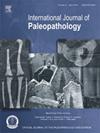Embracing complexity. Porous cranial lesions and their paleopathological significance in two population samples from Neolithic Northern Germany
IF 1.5
3区 地球科学
Q3 PALEONTOLOGY
引用次数: 0
Abstract
Objective
To assess phenotypic variation of porous cranial lesions and their co-occurrence with infections of the upper respiratory apparatus and endocranial lesions, to infer disease burden in two different Neolithic socio-economic groups.
Materials
Human skulls of at least 111 individuals from a collective grave at Sorsum (farmers) and 30 individual biurials at Ostorf (aquatic foragers) from northern Germany (c. 3300–2900 BCE).
Methods
A new data recording protocol for scoring porous cranial lesion phenotypic variation and the assessment of inter- and intra-site frequencies and anatomical distribution. Statistical analysis of lesion frequencies and co-occurrences.
Results
High odds of porous cranial lesions and upper respiratory apparatus lesions co-occurrence, and of subperiosteal new bone formation of the vault (a porous cranial lesion phenotype) and endocranial lesions, are noted for both sites. Site-specific phenotypic profiles and distribution patterns differ. For Sorsum, juvenile individuals show greater porous cranial lesion frequencies and active lesions.
Conclusions
Considering disease interplay is key for understanding porous cranial lesion phenotypic variation. Disease profiles can be associated with subsistence strategies. The results rule out dichotomic models (e.g. “civilization stress”) and support more nuanced reconstructions of the Neolithic social-economic transformations.
Significance
This study emphasizes the need to adopt data recording protocols that include a wider range of porous cranial lesions to understand overlapping pathophysiological pathways.
Limitations
Considerable preservation bias of the population samples. Inter-observer error is to be tested. Radiographic analyses are needed to corroborate the results.
Suggestions for further research
Further studies on larger assemblages from different geographical and chronological contexts are needed.
拥抱的复杂性。德国北部新石器时代两个人群样本的多孔性颅骨病变及其古病理学意义
目的评估多孔性颅脑病变的表型变异及其与上呼吸道感染和颅内病变的共发情况,推断新石器时代两个不同社会经济群体的疾病负担。材料:在德国北部(公元前3300-2900年)的Sorsum(农民)集体坟墓中发现了至少111个人类头骨,在Ostorf(水生觅食者)发现了30个生物头骨。方法采用一种新的数据记录方法,对多孔性颅骨病变的表型变异进行评分,并对其位点间和位点内频率及解剖分布进行评估。病变频率及共现的统计分析。结果多孔性颅骨病变和上呼吸道病变同时发生的几率很高,骨膜下穹窿新骨形成(多孔性颅骨病变表型)和颅内病变在这两个部位都是显著的。位点特异性表型特征和分布模式不同。对于Sorsum,青少年个体表现出更大的多孔性颅骨病变频率和活动性病变。结论考虑疾病间的相互作用是理解多孔性颅骨病变表型变异的关键。疾病概况可与生存策略相关联。研究结果排除了二分模型(如“文明压力”),并支持对新石器时代社会经济转型进行更细致入微的重建。本研究强调需要采用包括更广泛的多孔性颅骨病变的数据记录方案,以了解重叠的病理生理通路。局限性:总体样本存在相当大的保存偏差。观察者之间的误差有待检验。需要放射学分析来证实结果。进一步的研究建议需要对不同地理和时间背景下的大型组合进行进一步的研究。
本文章由计算机程序翻译,如有差异,请以英文原文为准。
求助全文
约1分钟内获得全文
求助全文
来源期刊

International Journal of Paleopathology
PALEONTOLOGY-PATHOLOGY
CiteScore
2.90
自引率
25.00%
发文量
43
期刊介绍:
Paleopathology is the study and application of methods and techniques for investigating diseases and related conditions from skeletal and soft tissue remains. The International Journal of Paleopathology (IJPP) will publish original and significant articles on human and animal (including hominids) disease, based upon the study of physical remains, including osseous, dental, and preserved soft tissues at a range of methodological levels, from direct observation to molecular, chemical, histological and radiographic analysis. Discussion of ways in which these methods can be applied to the reconstruction of health, disease and life histories in the past is central to the discipline, so the journal would also encourage papers covering interpretive and theoretical issues, and those that place the study of disease at the centre of a bioarchaeological or biocultural approach. Papers dealing with historical evidence relating to disease in the past (rather than history of medicine) will also be published. The journal will also accept significant studies that applied previously developed techniques to new materials, setting the research in the context of current debates on past human and animal health.
 求助内容:
求助内容: 应助结果提醒方式:
应助结果提醒方式:


